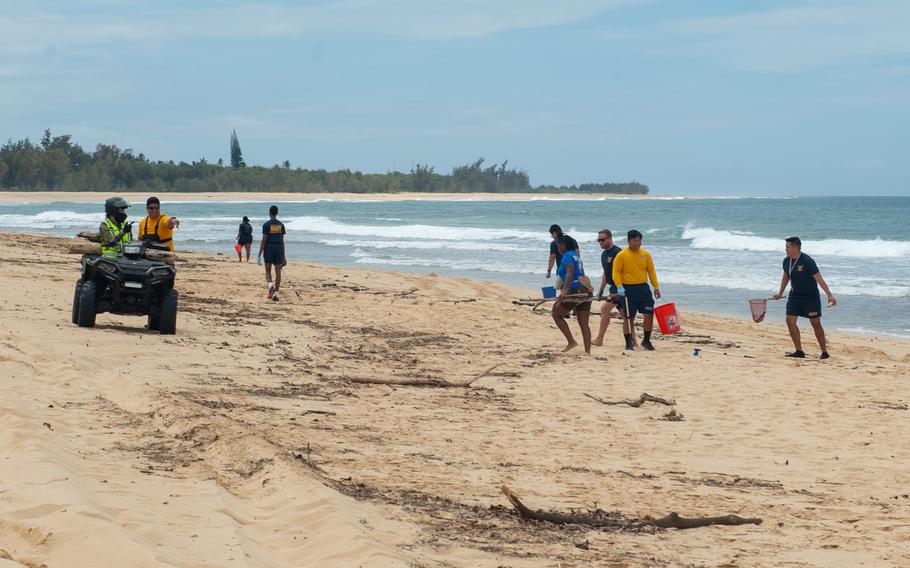
Sailors assigned to Pacific Missile Range Facility Barking Sands in Kauai, Hawaii, look for debris during an Earth Day beach cleanup on April 26, 2024. (Bodie Estep/U.S. Navy)
The U.S. Navy and the University of Hawaii have signed a 10-year agreement aimed at leveraging the institute’s expertise to bolster climate resilience and protect natural and cultural resources on Navy and Marine Corps bases in the state.
The agreement covers Joint Base Pearl Harbor-Hickam and Marine Corps Base Hawaii on Oahu and Pacific Missile Range Facility Barking Sands on Kauai, the university and service said Monday in a joint news release.
It enables the Navy to provide $10 million in annual funding to the university for projects that will increase resilience against environmental hazards at the bases, the news release states.
“With increasing threats of extreme weather, defense programs throughout the U.S. are investing in collaborations that will allow them to better understand and address the ways severe weather and other hazards could impact military missions,” the release states.
In September, the Defense Department issued its climate adaptation plan for the years 2024-27 that focuses on several lines of effort, including installation resilience and enhancing adaptation and resilience through collaboration.
“Interagency and academic partnerships … are critical to develop and test new technologies that ensure the DOD can operate under changing climate conditions, preserve operational capability, and enhance the natural and man-made systems essential to the Department’s success,” the plan states.
The Navy agreement provides the framework for the university to “use its collective knowledge and resources — scientists, laboratories, students, and outreach programs — to help the [Department of the Navy] balance the critical needs and requirements of the nation’s defense with its ongoing natural and cultural resource responsibilities in Hawaiʻi,” the release states.
It is the first agreement of its kind between an academic institution and Navy Region Hawaii and Marine Corps Installations Pacific, according to the release.
“Those who live and work in Hawaiʻi have a responsibility to be good stewards of the land and this partnership with the Navy signifies their willingness to fulfill their natural and cultural resource responsibilities by utilizing UH’s knowledge and expertise in these areas,” Vassilis Syrmos, the university’s vice president for research and innovation, said in the release.
Meredith Berger, assistant secretary of the Navy for energy, installations and environment, signed the agreement on behalf of the service.
The Navy will “benefit tremendously from [the university’s] world-class research, specialized training programs, and the traditional ecological knowledge,” she said in the release.
Among the support services the University of Hawaii could provide under the agreement are biological assessment development; cultural resource management; pest and predator control; marine debris removal; land and sea surveys; shoreline stabilization; wildfire management and planning; floodplain analysis; and sea-level rise mitigation.
Rep. Ed Case, D-Hawaii, who serves on the House Committee on Natural Resources, lauded the arrangement.
“This first-of-its-kind agreement between our flagship university and our Hawai‘i military is a win-win all around,” he said in the release.
“For the U.S. Navy, it demonstrates a commitment to draw on our local talent and expertise and cultural awareness wherever possible to advance national defense needs in our Hawai‘i and beyond as respectful neighbors,” Case said.